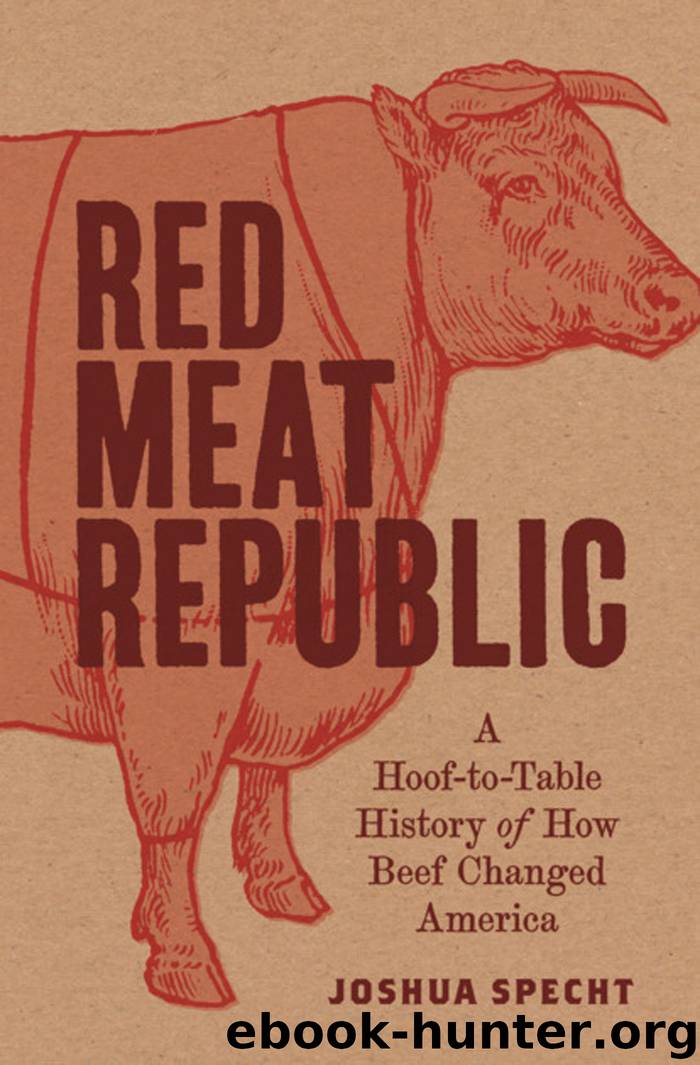Red Meat Republic by Specht Joshua;

Author:Specht, Joshua;
Language: eng
Format: epub
Publisher: Princeton University Press
Published: 2019-02-27T05:00:00+00:00
FIGURE 8. 1906 photograph of a Swift & Company slaughterhouse in Chicago. The animals are hung from hooks to allow ease of movement and then split (right side of image). Library of Congress. Next, a worker cut the animal’s throat and drained and collected its blood while another group began skinning the carcass. Even this relatively simple process was subdivided throughout the period. Initially the work of a pair, nine different workers handled skinning by 1904.17 Once the carcass was stripped, gutted, and drained of blood, it went into another room where highly trained butchers cut the carcass into quarters. These quarters were stored in giant refrigerated rooms to await distribution.
Though this description may make readers today squeamish, the nineteenth-century public’s fascination with the process was linked to a dark humor in which the animal’s suffering was never out of mind. One early twentieth-century Armour & Company postcard depicted hogs hanging from a wheel, with the caption “Round goes the wheel to the music of the squeal.”18 Similarly, the pamphlets of Milwaukee firm Cudahy & Company bragged that modern food processing had allowed the industry to “save the world from starvation and confound the disciples of Malthus” before joking that, from the steer’s perspective, “the purgatory of the stockyards is but the entrance to the inferno of the packing-house,” with its “clouds of steam, ever evilly rising, suggest[ing] never-ending torments.”19 An Armour pamphlet joked about “Billy the Bunco Steer” as a kind of employee.20 His job was:
to lead the unsuspecting train load of cattle from the cattle pens to the slaughterhouse … when the time to move arrives “Billy” takes his victims in hand, and having probably communicated to them in bovine language that there is something good to eat over the way he marches deliberately at the head of his regiment and delivers them safely within the slaughter-house pens. Having thus betrayed his friends, he turns cooly and marches off to perform the same service for another load.21
This fascination with the animal’s perspective accompanied a total lack of interest in the disassembly line’s other participant, the worker. The pages of Scientific American were filled with descriptions of disassembly lines for pork, cattle, and even sheep, but laborers were largely ignored in popular accounts of meatpacking.22 Yet, as much as the division of labor, the disassembly line owed its existence to a labor regime and labor pool that enabled it.
The profitability of what happened inside Chicago’s slaughterhouses depended on the throngs of men and women outside them, hoping to find a day’s or a week’s employment.23 An abundant labor supply meant the packers could easily replace anyone who balked at paltry salaries, or, worse yet, tried to unionize. Similarly, productivity increases risked worker injury, and therefore were only effective if people like Vincentz Rutkowski could be easily replaced. Fortunately for the packers, late nineteenth-century Chicago was full of people desperate for work.
Seasonal fluctuations and the vagaries of the nation’s cattle markets conspired to marginalize slaughterhouse labor. Though refrigeration helped the
Download
This site does not store any files on its server. We only index and link to content provided by other sites. Please contact the content providers to delete copyright contents if any and email us, we'll remove relevant links or contents immediately.
Craft Beer for the Homebrewer by Michael Agnew(17933)
Marijuana Grower's Handbook by Ed Rosenthal(3512)
Barkskins by Annie Proulx(3191)
Project Animal Farm: An Accidental Journey into the Secret World of Farming and the Truth About Our Food by Sonia Faruqi(3018)
Red Famine: Stalin's War on Ukraine by Anne Applebaum(2816)
The Plant Messiah by Carlos Magdalena(2745)
0041152001443424520 .pdf by Unknown(2593)
Organic Mushroom Farming and Mycoremediation by Tradd Cotter(2565)
In the Woods by Tana French(2411)
Beer is proof God loves us by Charles W. Bamforth(2250)
7-14 Days by Noah Waters(2247)
The Art of Making Gelato by Morgan Morano(2160)
Reservoir 13 by Jon McGregor(2144)
Meathooked by Marta Zaraska(2144)
Birds, Beasts and Relatives by Gerald Durrell(2135)
Borders by unknow(2117)
The 7 Habits of Highly Effective People: Powerful Lessons in Personal Change (25th Anniversary Edition) by Covey Stephen R(2080)
Between Two Fires by Christopher Buehlman(2041)
The Lean Farm Guide to Growing Vegetables: More In-Depth Lean Techniques for Efficient Organic Production by Ben Hartman(2010)
